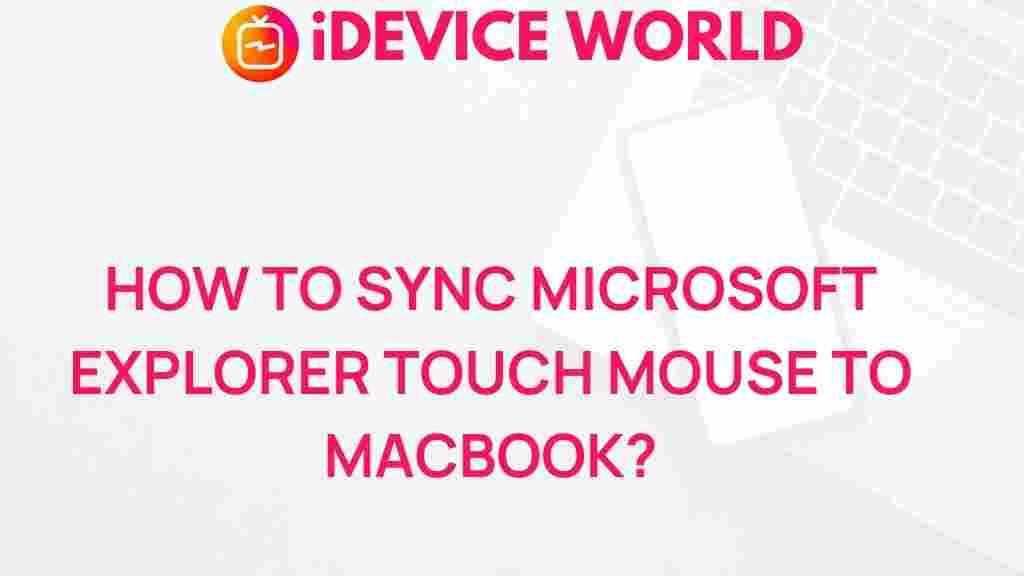Microsoft Explorer: Syncing Your Touch Mouse to a MacBook
The world of technology often presents challenges, especially when it comes to cross-platform compatibility. One common task users face is syncing devices across different operating systems. If you own a Microsoft Explorer Touch Mouse and want to use it with your MacBook, you may encounter some hurdles. However, this guide will provide you with a comprehensive step-by-step process to sync your mouse effortlessly. By the end of this article, you’ll be able to harness the full potential of your Microsoft Explorer Touch Mouse.
Understanding the Microsoft Explorer Touch Mouse
The Microsoft Explorer Touch Mouse is a versatile and ergonomic device that offers a range of features, making it a favorite among both casual users and professionals. It boasts a sleek design and utilizes touch technology for seamless navigation. Some key features include:
- Touch-sensitive scrolling
- Customizable buttons
- Ergonomic design for comfort
- Long battery life
Despite its excellent features, connecting the Microsoft Explorer Touch Mouse to a MacBook may require some additional steps, especially since it’s primarily designed for Windows. Let’s dive into how you can sync your mouse with your MacBook effectively.
Step-by-Step Process to Sync Microsoft Explorer Touch Mouse to MacBook
Step 1: Check Compatibility
Before diving into the syncing process, it’s essential to ensure that your MacBook is compatible with the Microsoft Explorer Touch Mouse. The mouse supports Bluetooth connectivity, so make sure your MacBook has Bluetooth capability enabled. Most modern MacBooks do, but it’s always good to double-check.
Step 2: Prepare Your Mouse
To prepare your Microsoft Explorer Touch Mouse for syncing:
- Ensure that the mouse is powered on. You can usually find a power switch on the bottom of the device.
- Remove any USB dongle if you previously used the mouse with a Windows computer. The Bluetooth feature will be utilized for syncing with your MacBook.
- Replace the batteries if the mouse is unresponsive.
Step 3: Enable Bluetooth on Your MacBook
Follow these steps to enable Bluetooth:
- Click on the Apple logo in the top left corner of your screen.
- Select “System Preferences” from the dropdown menu.
- Click on “Bluetooth.”
- Ensure Bluetooth is turned on. If it’s off, click “Turn Bluetooth On.”
Step 4: Pair Your Mouse
With Bluetooth enabled, you can now pair your Microsoft Explorer Touch Mouse:
- Put your mouse into pairing mode. Usually, this involves holding down the Bluetooth button on the mouse until a light flashes.
- On your MacBook, look for your mouse under “Devices” in the Bluetooth settings.
- Click on the name of your mouse when it appears and select “Connect.”
- Once connected, you should see a confirmation message indicating the successful connection.
Step 5: Test the Connection
After pairing, test your Microsoft Explorer Touch Mouse:
- Move the mouse to see if the cursor responds.
- Test the scrolling feature to ensure it’s functioning correctly.
Troubleshooting Common Issues
If you encounter issues while syncing your Microsoft Explorer Touch Mouse, here are some troubleshooting tips:
Mouse Not Found in Bluetooth Settings
- Ensure the mouse is in pairing mode. If the light isn’t flashing, try turning it off and on again.
- Check if the mouse is compatible with your MacBook.
- Remove any interference from other Bluetooth devices nearby.
Mouse Disconnects Frequently
- Check the battery level of your mouse. Low batteries can lead to connectivity issues.
- Move closer to your MacBook to eliminate distance-related problems.
- Reset your mouse by turning it off for a few seconds and then back on.
Touch Features Not Working
- Ensure that any required drivers are installed on your MacBook. Visit the Microsoft Support Page for updates.
- Try using the mouse on a different surface to see if it improves responsiveness.
- Check if your MacBook has any accessibility settings that may affect touch functions.
Advanced Configuration Options
Once you’ve successfully synced your Microsoft Explorer Touch Mouse, you may want to explore some advanced configuration options:
Customizing Mouse Buttons
You can customize the functions of your mouse buttons using the Microsoft Mouse and Keyboard Center. While this software is primarily for Windows, you can use third-party applications such as X-Mouse Button Control on Mac to achieve similar results.
Adjusting Scroll Speed
To enhance your experience, consider adjusting the scroll speed:
- Go to “System Preferences” on your MacBook.
- Select “Mouse” and adjust the scroll speed slider to your liking.
Conclusion
Syncing your Microsoft Explorer Touch Mouse with a MacBook may seem daunting at first, but with the right steps, it becomes a straightforward process. Remember to check compatibility, enable Bluetooth, and put your mouse into pairing mode. If you encounter any issues, utilize the troubleshooting tips provided in this guide.
By unlocking the potential of your Microsoft Explorer Touch Mouse, you can enhance your productivity and enjoy a seamless user experience across different operating systems. Don’t hesitate to explore the advanced configuration options to make the most of your device.
This article is in the category Guides & Tutorials and created by iDeciveWorld Team
